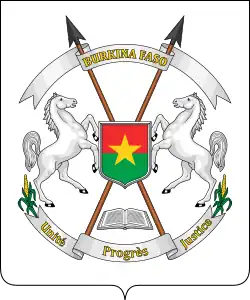Burkinabé Communist Group
Burkinabé Communist Group | |
|---|---|
| Founded | 1983 |
| Dissolved | 1991 |
| Split from | Voltaic Revolutionary Communist Party |
| Succeeded by | Movement for Socialist Democracy |
| Ideology | |
| Political position | Far-left |
 |
|---|
The Burkinabè Communist Group (French: Groupe Communiste Burkinabè, GCB) was a communist party in Burkina Faso.
History
The GCB was formed as a splinter from the Voltaic Revolutionary Communist Party in August 1983, following the refusal of PCRV to support the revolutionary government of Thomas Sankara.[1] The GCB was lead by Jean-Marc Palm.[2]
On 22 May 1985, the GCB, along with the Union of Burkinabé Communists, was re-invited into the Burkinabe governing coalition under the National Council for the Revolution (CNR) in order to counter the influence of Valère Somé within the faction.[2]
In 1986 the GCB signed a declaration, together with the Union of Communist Struggles – Reconstructed (ULC-R), Union of Burkinabé Communists and Revolutionary Military Organization, calling for revolutionary unity.[2]
In April 1987, the GCB, together with the ULC-R and La Flamme, formed a formal front against Sankara and Somé.[2]
In 1989 the GCB left the government, following its refusal to join ODP/MT. The GCB turned clandestine. In April 1989 it split into two factions, one led by Salif Diallo joined the ODP/MT. The other, led by Jean-Marc Palm, became the Movement for Socialist Democracy (MDS) in March 1991.
Members
- Jean-Marc Palm (founder)[2]
- Salif Diallo[3]
References
- ^ Hagberg, Sten (2025-07-30). "Pain et liberté pour le peuple! Burkina Faso's Underground Communist Party PCRV, and its Public Presence in the Anti-Imperialist Struggle". African Studies Review: 1–21. doi:10.1017/asr.2025.10021. ISSN 0002-0206.
- ^ a b c d e Genova, James (2022-11-01). Making New People: Politics, Cinema, and Liberation in Burkina Faso, 1983–1987. MSU Press. pp. 128–130, 150–153, 168–169. ISBN 978-1-62895-477-7.
- ^ "Relations entre Blaise Compaoré et Salif Diallo : Le mythe et la réalité - leFaso.net". lefaso.net (in French). Retrieved 2025-08-06.